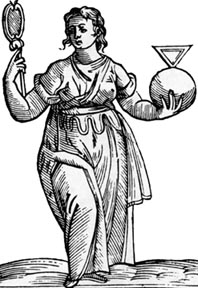 June – September 2001
June – September 2001
In the annals of history, Hypatia of Alexandria (370-415) is the first female scientist for whom there exists more than sketchy documentation. She is notable because she was a brilliant scientist – well versed in mathematics, astronomy, and philosophy – and well respected by many. She is also notable because she was well-educated at a time when the rigorous education of women was an anomaly. Hypatia had her father, a great believer in education, to thank for her upbringing. In other circumstances she would have lacked the opportunity to live such an unusual life, and her discoveries would have been left to others at a later time.
Over the centuries this story would repeat itself again and again. An academic education in the sciences was rare or inaccessible to most women. In the 17th century, salon discussions or lectures about the sciences were fashionable. Some were exclusively female while others included male members but were run by women. These activities were a substitution for the academies and official scientific societies to which women were still not generally admitted as full members, although they sometimes worked on the periphery. Self-education, especially among the noble classes, was common and women of means were ready consumers of scientific literature and curiosities. High-ranking women with a serious interest in the sciences were able to take advantage of class-based networks that included nobility and royalty, and permitted access to important contemporary scientists such as Descartes and Newton.
Like Hypatia, many women entered the sciences through a relative, as assistants to their fathers, brothers, and husbands. And while many of these women were able to make significant contributions within their fields, the joint nature of their work often led to the exclusion or misattribution of their contributions. Within the tradition of the crafts guild a wife, daughter or niece of a guild master was permitted to learn his trade, and women were granted limited civil rights and guild memberships which permitted them to work more independently. This helps to explain the number of female German astronomers, 14%, during the 17th century. However, ultimately, when women did occupy a niche in science, it would often become masculinized and women’s contributions would be diminished or appropriated.
Christian Harless, a German physician, wrote in 1830, that in the “long standing gap in the history of the natural sciences there has been no historical and evaluative survey of all the women who, from the earliest times until our own, have distinguished themselves in the various sciences,” (cited in The Mind Has No Sex? by Londa Schiebinger, Harvard University Press, 1989). Since the 1970s, with an increasing number of women entering scientific fields, there has been a corresponding interest in the history of women in the sciences. The individuals showcased in this exhibit represent only a tiny percentage of the women who have worked in the sciences from earliest times and for whom there are records. While not comprehensive, the exhibit may spark an appreciation for the contributions of women in these and other areas. May they shine the light of discovery on others.
Prepared by Lisa Martincik, Marguerite Miller, Brenda Molife, Marguerite Perret, Rijn Templeton, and Kristin Baum.
